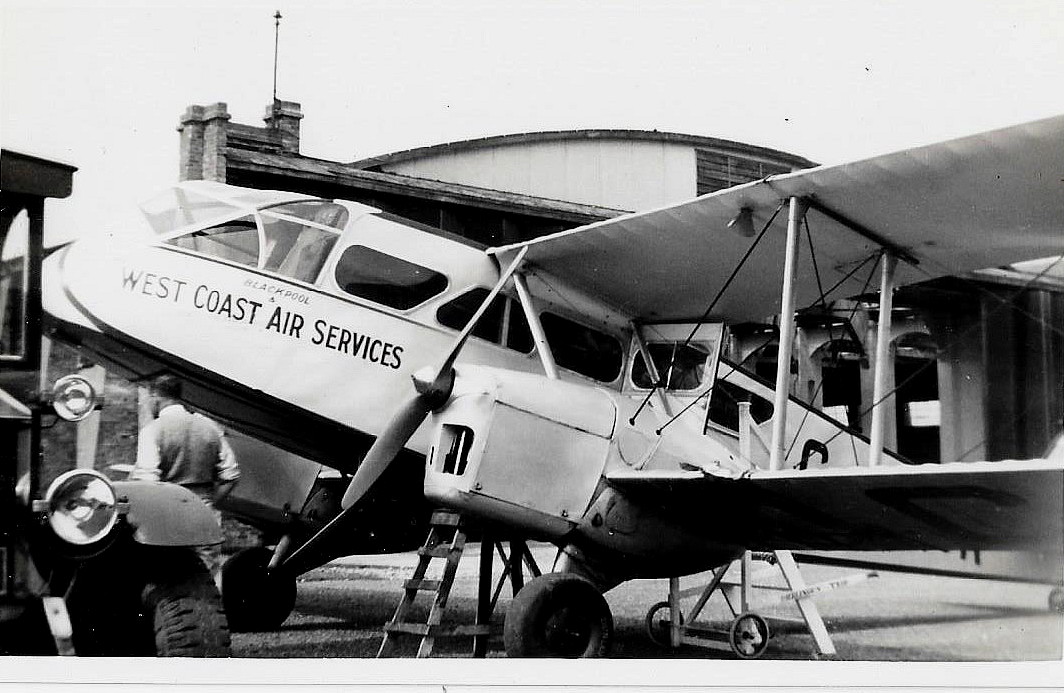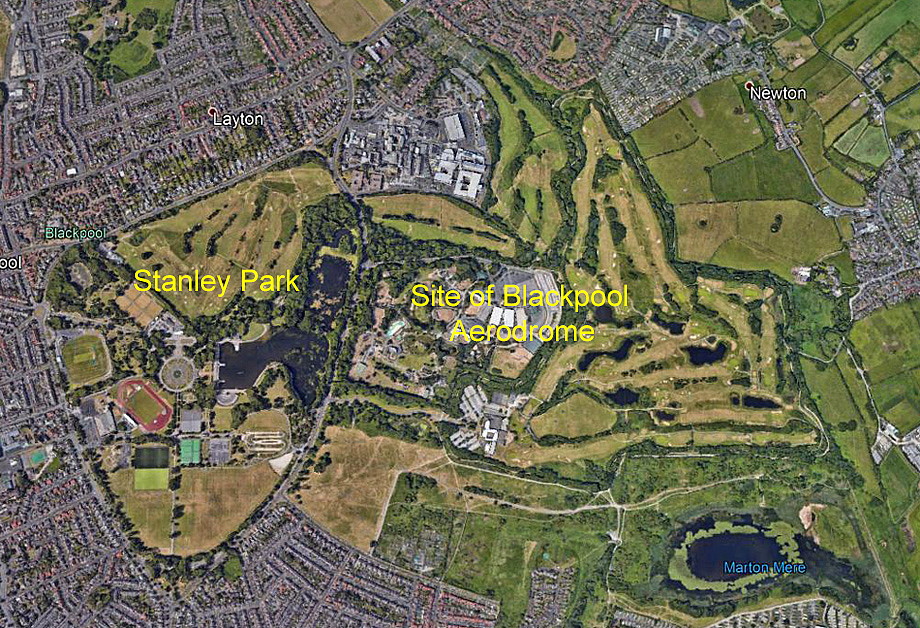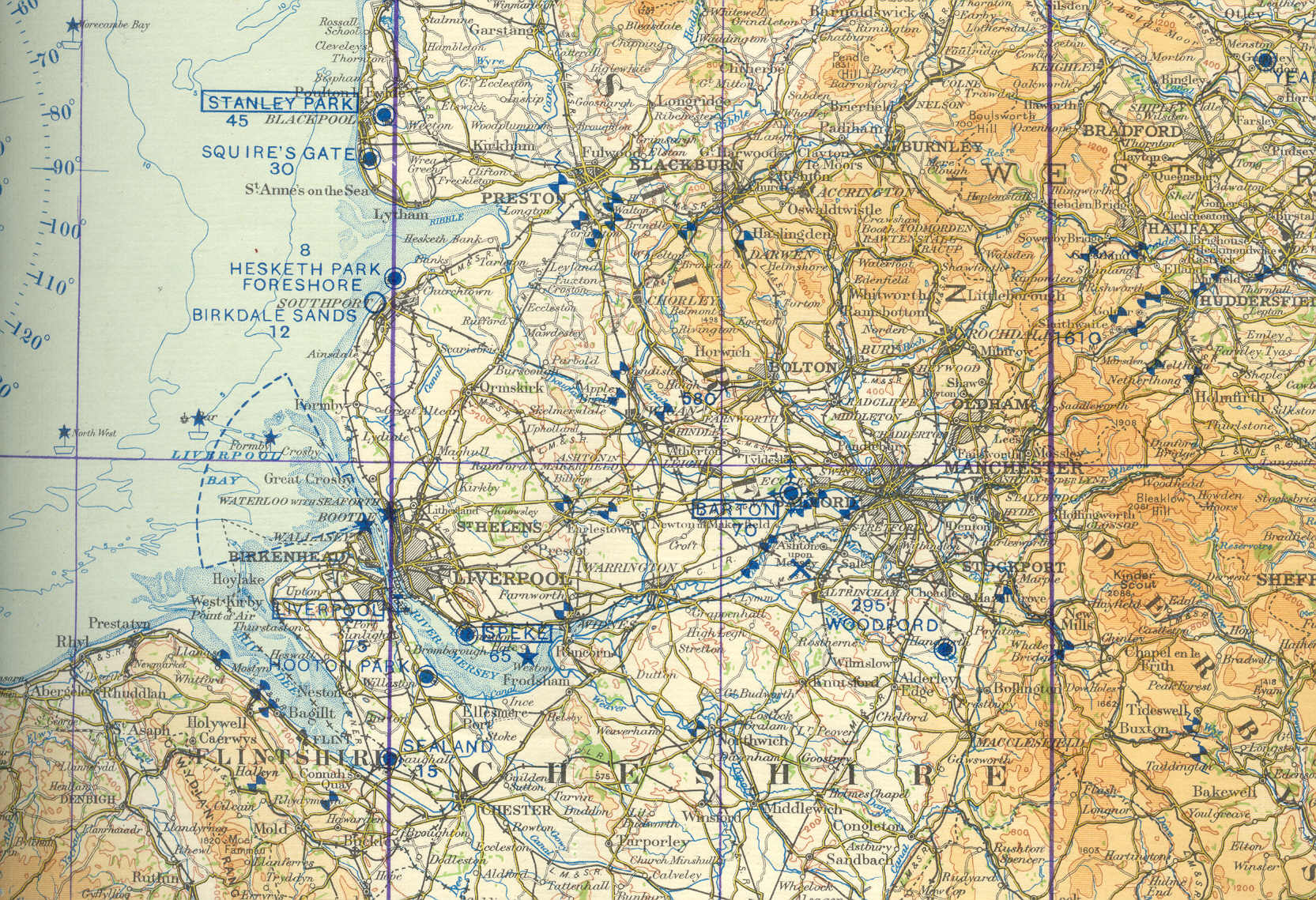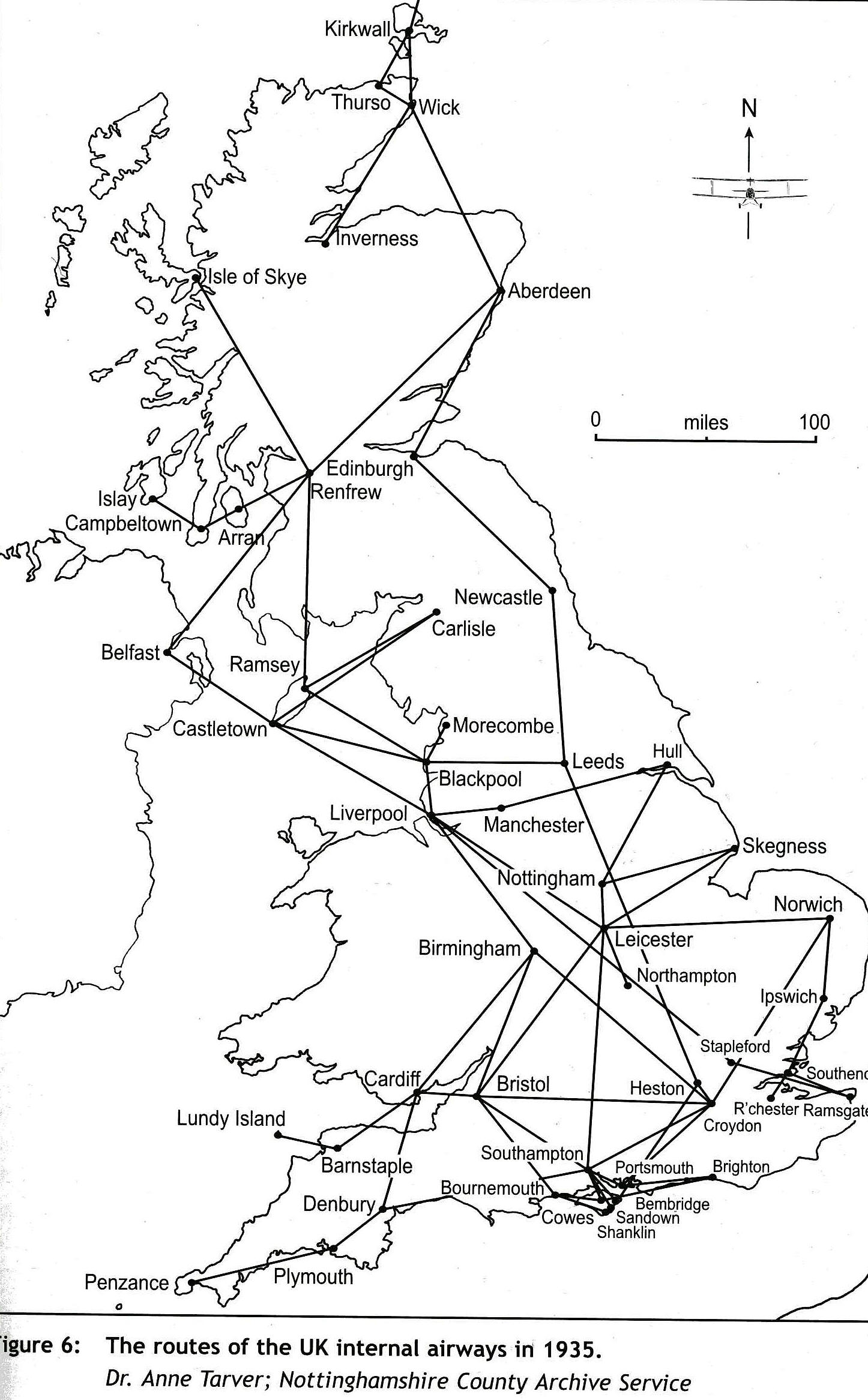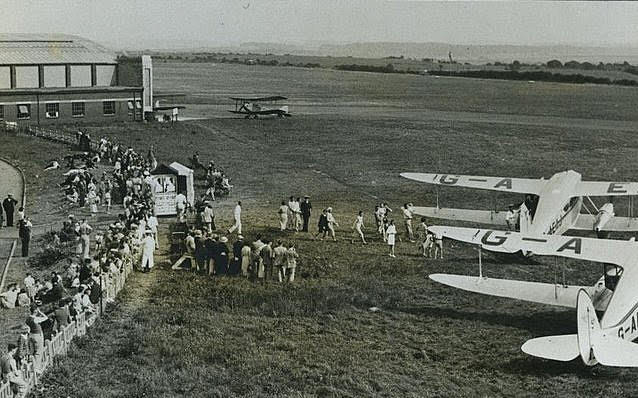Blackpool Stanley Park
STANLEY PARK: Civil regional airport
Please forgive my indulgence but I do think it might be of interest for anybody starting out to find out about our airfields and airports. In the early days I made these notes; Before WW2 it appears that the Blackpool Municipal Airport was located at STANLEY PARK which was a few miles N to NNE of SQUIRES GATE.
Because so many records simply state BLACKPOOL it was a very confusing matter to try and separate these two sites and indeed for a short time I’d simply assumed they must be the same. Today I know they were indeed two entirely different locations. This confusion about what must surely be two of the better known flying sites in England (during the 1930s) just goes to show how devilishly difficult it can be to research aviation history, especially when starting out, as I simply did not know who to believe. Once again, if you’ll excuse a bit of advertising, proof that a basic ‘Guide’ can prove very useful
Operated by: 1929: National Flying Services
1933: Blackpool and West Coast Air Services
1934: Midland & Scottish Air Ferries 1935: Whitehall Securities (United Airways)
The John Stroud Collection
British airline users: Pre 1940: Blackpool and West Coast Air Services, British Amphibious Air Lines, Isle of Man Air Services, Midland & Scottish Air Ferries, Railway Air Services, Spartan Airlines, United Airways
A MIKE CHARLTON GALLERY
Note: These four pictures from postcards were kindly sent by Mike Charlton was has an amazing collection. See: www.aviationpostcard.co.uk
First picture: The de Havilland DH84 Dragon II G-ADCP was first registered on the 30th March 1935, and presumably went to West Coast Air Services, with which it appears to have served until it went, on the 19th October 1937 to Isle of Man Air Services based at the Isle of Man Airport, Derbyhaven. We now know this airport as RONALDSWAY. It served here until the 4th April 1940 when it was impressed as X9440. But, can anybody kindly identify where this picture was taken?
Second picture:This example, the DH84 Dragon II G-ADCR was first registered on the 6th March 1935, about three weeks before G-ADCP (above) for some reason. It was operated by Blackpool & West Coast Air Services, based at nearby SQUIRES GATE incidentally, until it crashed on the 25th July 1938. It was not de-registered until the 1st January 1939, so perhaps it might have been considered as a rebuild project? Here again, can anybody kindly identify where this picture was taken?
Third picture: From what little can be seen, I suspect this is probably G-ADCR, and without little doubt on the apron at STANLEY PARK.
Charter/air taxi: Pre 1939: Blackpool & Fylde Aero Club, Blackpool and West Coast Air Services
Pleasure flights: Pre 1939: Blackpool Flying Services, Blackpool and West Coast Air Services, British Airways, Lancashire School of Aviation, United Airways, Utility Airways
Notes: This picture from a postcard was also kindly sent by Mike Charlton. Having spent at least three hours trying to pin this aircraft down - I have failed dismally in every respect. I could not find any reference to Utility Airways, but I assume they were engaged in pleasure flights? I think it could be a GAL ST-4 Monospar? This said I cannot find, searching the history of GAL 'Monospar' types, any reference to one operated by Utility Airways. If anybody can kindly offer advice, this will be much appreciated.
THE ANSWER
In July 2023 Mr Graham Frost, a great friend of this 'Guide', provided me with the answer. This was the GAL Monospar ST-25 Jubilee, G-AEDY, registered to Utility Airways from 26.05.39 to 03.01.40, and based at HOOTON PARK. Probably being used for an air taxi service? It had previously been registered to Aircraft Facilities Ltd, also at HOOTON PARK, from 12.01.37 until 09.05.39.
A MICHAEL T HOLDER GALLERY
Note: The first item, a short newspaper article, was published in the Burnley Express on the 7th August 1929
Note: The sixth item was published in the Leeds Mercury on the 3rd August 1929. The eighth item was added from my database which is based on pictures obtained from Google Earth ©
AN AUSPICIOUS VISITOR
Sir Alan Cobham flew across from RONALDSWAY on the 5th August 1929 to help celebrate the opening of the aerodrome. This was the 49th venue for his Municipal Aerodrome Campaign, a tour that started in May and ended in October. Initially 107 venues were planned to be visited, but in the end due to a couple of minor crashes and other unforeseen problems, he managed to arrive at 96. Which of course was still a magnificent achievement.
The aircraft he mainly used was the de Havilland DH61 'Giant Moth' G-AAEV, named 'Youth of Britain'. This was a single-engine ten-seater airliner type. His typical itinery was first to fly the local dignitaries around the area, sometimes needing up to four flights, followed by a slap-up luncheon when he would extol the virtues and benefits of having a local aerodrome/regional airport. He would then take at least forty selected school children for local flights, these being sponsored by Lord Wakefield of Castrol Oil fame, although he preferred to remain anonymous.
Following on from all this, he would then take fare paying passengers up on short flights, typically until dusk. No doubt using this revenue to offset the costs of the tour. Renowned as being a 'workaholic', even so his drive, determination and sheer stamina, remain awesome to this day. But of course, the effects of culminative fatigue were unknown about in those days, and today we must wonder to what extent these influenced his mishaps.
It also appears that Cobham allowed himself a break from flying every day here, since May! But, no doubt, he was busy arranging the rest of the tour. Having arrived on the 5th August, it seems he departed for SOUTH DENES, (Great Yarmouth), on the 9th.
Flying club/schools: Pre 1940: Blackpool & Fylde Aero Club, Lancashire School of Aviation, Liverpool & District Aero Club
PICTURES FROM 2016
Note: On a visit in 2016 I was astonished to discover that the buildings used by the zoo were in fact the two hangars from the 1930s, and, the buildings in between are those built in WW2. During WW2 aircraft such as Hawker Hurricanes and Avro Lancasters were repaired and replenished here. However, the zoo site only takes up part of the aerodrome site.
Being a tad 'anoraky' the first picture is the back of the hangar shown above in the B&W photographs.
Location: Now the Blackpool Zoo site, about 1.6nm ESE of the North Pier
Period of operation: 1929 to 1947?
Runways: It was a small site of just 120 acres.
SE/NW 411 grass NE/SW 640 grass
In 1934 (?) the NE/SW runway was extended to 914 metres
NOTES:
In 1928 the Blackpool Flying Pageant was held. Amongst the visitors was the Suffolk and Eastern Counties Aeroplane Club, then based at HADLEIGH in SUFFOLK with one or both of their Blackburn Bluebirds? Presumably this event took place at this site?
The official opening was in August 1929
FLYING CIRCUS VENUE
Was this site the Blackpool venue for Modern Airways, (The Crimson Fleet), ‘Tour of the UK’ display on the 15th June 1932? The same question applies to the Blackpool venue for Sir Alan Cobham’s National Aviation Day UK Display Tour on both the 26th and 27th June 1932. I know big aviation events were a huge ‘draw’ in the 1930s, (they still are of course), but with Cobham’s fleet following hard on the heals of the Modern Airways tour was their visit a big success here in June 1932? I suppose it must have been a success as the Cobham fleet returned here later the same year on the 5th September on their way to Scotland.
Blackpool is again listed as a venue for the 1933 Cobham No.1 Tour the display taking place on the 20th June and the 1933 No.2 Tour visited on the 8th August. In 1934 Cobham’s Tour displayed in/near Blackpool on the 23rd July and the next year on the 27th May before the Tour split into two divisions on the Ist of July. On the 7th September Blackpool is the venue for Cobham’s 1935 No.2 Tour. I would be delighted to learn whether or not all these displays took place at STANLEY PARK, and if not, exactly where they performed in the Blackpool area?
It was a common enough practise for these “Flying Circus” operators to deliberately select sites apart from established aerodromes simply because, (apart from several other practical and/or financial reasons), their aerial activities were so intense it made sense for them to have total control of the site. Indeed, flying activities often continued after dark on various plain field sites with the only runway illumination being provided by one of the support lorries. It seems the fuel tanker(s) were usually preferred as these lorries had more powerful headlights! I’m assuming the Cobham enterprise were using more than one tanker?
NOTES ON THE REGIONAL AIRLINES
In his excellent book The Triple Alliance Neville Doyle has this to say: “Much to the annoyance o the Blackpool Corporation, the airfield lease was sold to Blackpool and West Coast Air Services Ltd. This company started with two D.H. Fox Moths G-ACFC
and G-ACFF for charter services plus the Avro Avians G-EBXX and G-EBXY for joy-riding and instruction. From June 1933, BWCAS started regular services to the Isle of Man and Liverpool, using D.H. Dragon G-ACGU.”
Neville Doyle adds; “This proved strong competition for British Amphibious Air Lines which was disliked by the Blackpool Corporation because of Monk’s practice of taxying his Cutty Sark up on the beach to collect passengers, and in 1933 he, too, flew from Stanley Park. To reduce the number of flights over the area , he had agreed to use a larger machine for the 1934 season but, William Roberts at Spartan was holding all the available Saro Clouds to prevent Jersey Airways from buying them. With circumstances all against him, Monk decided to discontinue his airline and joined PSIOWA (My note: Portsmouth, Southsea & Isle of Wight Aviation) as a pilot, shortly afterward moving to Spartan to fly their Saro Cloud!”
For Flying Officer Ronald Monk this must have been a rather devastating turn of events and it does serve to illustrate that although the regional airlines suddenly blossomed in the early 1930s, it was still, for many participants, a very tough and ruthless business. Even the biggest and most successful, in truth, often depended on some form of subsidy or support. This making it doubly difficult for independent operators of course.
A POOR CHOICE OF LOCATION
To emphasise what a poor choice Sir Alan Cobham had made in recommending an aerodrome here, and how the trust of the Blackpool Corporation was misplaced; again from Neville Doyle: “Blackpool Corporation also disliked joy-riding aircraft from Stanley Park flying over the surrounding residential area…” Well – what the hell did they expect would be the outcome? Incredibly Neville Doyle quotes from the West Lancashire Evening Gazette on the 5th December 1932; “The Council say that joy-riding is not enough, they want all the year round air services.” On another tack some experts today reckon that if a modern ‘IQ’ test was applied to the majority of people in the 1930s they would register less than ‘70’ therefore rendering them classified today as ‘Moron – moderate disability’. The above seems to prove this is correct!
SOME HISTORY OF THE SITE
The history of STANLEY PARK in and around 1935 is so complicated I really cannot go into the details here, but highly recommend reading is Neville Doyle’s excellent book, The Triple Alliance, from which I quote: “At a discussion at Whitehall Securities offices….Lynch-Blosse reported that two Cruisers were ready for transfer to Blackpool, G-ACDX (without wireless) and G-ACYL (with wireless).” Flying without a ‘wireless set’ or ‘radio’ as we now call it, is still permitted today although entry into controlled airspace is normally only allowed with prior agreement..
“United’s lease on Stanley Park became effective on April15th 1935, and until regular services could be inaugurated, the Spartan Cruisers were kept busy joy-riding.” This amply illustrates the often temporary nature of the early airlines, forever seeking ‘market’ opportunities – as and when. There was virtually nothing of precedent to go on, the whole enterprise depended on people with vision ‘creating’ a demand for these services. Again from Neville Doyle it appears that when United Airways started operations on the 30th April 1935 they had acquired the DH.89 Dragon Rapide G-ADAE originally ordered by Northern & Scottish; “…followed by United’s own Rapides G-ADBU (C of A issued April 29th 1935) and G-ADBX (C of A issued July 4th 1935), both costing £3,800 each.”
If that now seems incredibly cheap it has to be borne in mind that in 1930 the average house price in the UK is given as £590! Needless to say any airline today would give their ‘eye-teeth’ to purchase a short range regional airliner for the price of about six and a half average priced houses. Accepting that such comparisons can be almost meaningless, I do think a very broad lesson can still be drawn. In 2012 the average price of a house in the UK was given as roughly £162,000 (about 275 times more) whereas the price of an Airbus 318 (a type which might well be used to fly from London to Liverpool in 2012) averages out at about £26.5 million (about 6974 times more). This, I suppose, can be called “the price of progress”?
Please don’t trust me on this because, as already said, trying to make simple comparisons is incredibly difficult. But a rough picture does emerge. For example the return fare asked by United Airlines from London to Blackpool in 1935 was 72/- (£3.12.00) – the average weekly wage being, apparently, about £3.14.00. In 2012 the average weekly wage is given as roughly £510 – the problem being, with current airline pricing policies – what the hell is an average price? Given that passengers in the mid-1930s probably booked at short notice I looked up the ‘next day’ return price of flying by Easyjet from Gatwick to Liverpool for February 2013– about the same distance.
The first thing noticed was that a ‘Google’ search revealed that the Easyjet website did NOT give GATWICK as an option to fly from! And GATWICK is their major hub. This said I do think they might well have offered a LIVERPOOL service from LUTON. Reverting to a ‘sub-contractor’ website this gave fares ranging from Ryanair asking £108, Easyjet £111 and Flybe £212. Therefore an average price of about £143. It does roughly appear that since 1935, compared to 2013, air fares on this sort of route have been reduced by 75%? Which of course opens the market up to ‘most’ people. Those who used such services in 1935 probably, (if they wish to fly), now hire executive helicopters or even ‘exec’ jets.
UNITED AIRWAYS
The United Airways fleet circa May 1935 consisted of:
DH.60 Moth Major G-ACNS
DH.89 Dragon Rapides G-ADAE, G-ADBU & G-ADBX
Spartan Cruisers G-ACDX, G-ACSM, G-ACYL & G-ACZM
I suspect more were in service (?) but these are aircraft which I believe were flying in ‘United Airways’ colours from April 1935, rather than airlines United Airways had controlling shares in but still operated under their original names, such as Highland Airways and Jersey Airways.
Neville Doyle in The Triple Alliance gives the United Airways fleet, 30th September 1935:
A.W.154 Argosy G-AACJ
DH.60 Moths G-AAYY & G-ACNS
DH.84 Dragons G-ACMC, G-ACNI & G-ACMJ
DH.89 Dragon Rapides G-ADAE, G-ADBU & G-ADBX
Spartan Cruisers G-ACDX, G-ACSM, G-ACYL & G-ACZM
Spartan 3-seater G-ABTR
Just to muddy the waters a bit more it seems that, for example, the United Airways ‘service’ from Liverpool (SPEKE) to ‘ESSEX Airport’ was perhaps operated by Hillman Airways? Another aspect which has plagued my research is airline timetables. For example, one published by United Airways in October 1935 refers to two destinations in London; “Heston Airport” and “Essex Airport”, the latter being STAPLEFORD TAWNEY. It can certainly get confusing because, up till 1934 it was MAYLANDS, aka ROMFORD that was “the” ESSEX AIRPORT .
There was it seems some co-operation between United and Hillman’s and indeed, eventually the two airlines merged. In fact more was going on with a major merger programme under way in 1935 with United Airways joining Spartan Air Lines in agreeing to merge with Allied British Airways, with Hillman’s following later. This operation being based at HESTON (LONDON).
What still astonishes me is the realisation that it wasn’t until the 1930s, arguably the mid-1930s, that internal airlines in the UK really got into their stride. Yet just four or five years later, at 11.15 AM on the 3rd September 1939, Prime Minister Neville Chamberlain broadcast to the nation, on the radio, that war on Germany had been declared. It was of course also during that really quite short period that the classic Short Bros ‘Empire’ C- Class flying boats had entered service with Imperial Airways, and, on the military side, the Hurricane and Spitfire had first flown.
The flight time from Blackpool (STANLEY PARK) to London (HESTON); “…with Rapides being allowed 90 minutes for the 195 mile flight.” In 2013 the flight time between HEATHROW and
MANCHESTER is given as 16 minutes, (according to one website – which is obviously very misleading) - so what might be a more realistic time needed from boarding to disembarking – plus time in the terminals? More like three hours at best? I have made comparisons with other popular destinations, such as CROYDON to LE BOURGET (Paris), and SCHIPOL (Amsterdam) and it seems very clear that transit times have not been improved on since the 1930s. And indeed, only the very foolish today would give themselves the absolute minimum time from check-in to boarding.
MORE NOTES
In 1935 the ex-Imperial Airways Armstrong Whitworth Argosy G-AACJ, previously used by the Alan Cobham NAD tour in 1932, spent the season with United Airways giving joy-rides. In fact it seems it flew during 1936 before being retired in December that year wearing tiny British Airways insignia.
According to Neville Doyle the Northern & Scottish fleet in August 1936 was:
DH.89 Dragon Rapides G-ADAG, G-ADAH, G-ADBU & G-ADDF
Spartan Cruisers G-ACSM, G-ACVT, C-ACYL, G-ACZM, G-ADEL & G-ADEM
Ten aircraft
In November 2021 Mr Andy Fleming sent me this great picture published in the Blackpool Gazette from a website. It was captioned as being taken in 1933. Clearly incorrect as the two aircraft in the foreground are de Havilland DH89 Dragon Rapides - and the first flight of this type was in April 1934.
WORLD WAR II
During early stages of WW2 SQUIRE’S GATE and STANLEY PARK were still regarded as being both separate and operational in their own right. For example at SQUIRE’S GATE VR (Volunteer Reserve) and E&RFTS (Elementary & Reserve Flight Training School) training was taking place and STANLEY PARK was used by 3 SoTT (which stands for what?) and acted as a MAP (Ministry of Aircraft Production) sub-site.
POST WW2
In late 2010 I found in Ron Smith’s book British Built Aircraft Vol.5 this intriguing information about the Lancashire Aircraft Corporation, and I’ll quote: “The company is best known for its post-war freight operations using Halifax and Halton aircraft. In mid-1947, a fleet of more than twenty aircraft was in operation, including, (in addition to the Halifax/Halton), Rapide, Consul, Proctor and Auster aircraft. The company also operated the last de Havilland DH86 Express in airline use.” But, here’s the bit I find so interesting for this project: he then goes on to say the operating bases included, BOVINGDON (HERTFORDSHIRE), STANSTED (ESSEX), YEADON (YORKSHIRE), SQUIRES GATE - and - STANLEY PARK! I have since learnt that LAC used their Rapide, (or Rapide’s), for charter flights from here. What’s the betting they also operated their Proctor(s) and Auster(s) too? The RAF No.181 Gliding School were also also the site after WW2. Today of course we have the marvel that is Wikipedia and barely a day goes by when I haven’t used this facility at least once. I have to say it is rare indeed that any information found on Wikipedia appears to disagree with information found from other sources which are generally acknowledged as being authorative. Indeed, it is from this source I discovered that it appears Blackpool Zoo still use the old terminal building and hangar from pre-war times plus three WW2 hangars.
STANLEY PARK COMES INTO EXISTENCE
According to Neville Doyle in his book The Triple Alliance: “In 1927, despite the existence of Squires Gate, Blackpool Corporation had invited Sir Alan Cobham to recommend a site for a municipal aerodrome and, of the various locations inspected, he gave first choice to an area east of Blackpool adjacent to Stanley Park. His advice was accepted and, in due course, Stanley Park was officially opened as a new aerodrome on June 2nd 1931, although it was operational almost a year earlier.” The distance between the two aerodromes is about 3.25 miles. “By the end of 1932, there was a hangar 120ft x 72ft overall, capable of holding 20 light aircraft, plus offices, workshop and stores. The nearby clubhouse had a dining room, lounge, and a bar on the ground floor, with three bedrooms on the first floor, and an observation tower.”
But, here comes the ‘crunch’: “Nevertheless, it was badly situated - “because, with the prevailing westerly winds, most take-offs had to be made over the centre of Blackpool. Very dangerous in the event of an engine failure.” This I find this very interesting. I don’t believe that Sir Alan Cobham would have paid much heed to the event of engine failure. Indeed, I cannot recall him having an engine failure during his famous flights to explore routes for Imperial Airways down to South Africa or across the Middle East and India. And, for that matter, I also cannot recall, whilst taking his fleet of aircraft on the various ‘Flying Circus’ tours around the UK in the early 1930s, a single incident being recorded due to engine failure – although I strongly suspect there surely must have some – or at least one?
In my flying career I have found many similar attitudes to the event of engine failure (in a single engine aircraft) being regarded as so remote it wasn’t worth considering by the authorities. This being the reason, for example, that I have flown at low level, over Auckland in New Zealand, Berlin, Cologne, Hannover and other cities in Germany, Helsinki in Finland, Lisbon in Portugal, Melbourne and Sydney in Australia, Rome in Italy (but you cannot fly near to the Vatican), Stockholm in Sweden and many others.
So then – case proved, nothing to worry about? In fact engine failure is still a fact of life and even the latest airliners and military aircraft suffer from such occurrences. For light aircraft it is still a common occurrence but nearly always confined to rural sites with minimum risk to the public. I trust it might interest you to know that although piston-powered single-engine aircraft have long been prohibited from flying over London; there are exceptions - notably the BBMF (Battle of Britain Memorial Flight) Spitfires and Hurricanes. Twins of course are allowed, but - these include some types which cannot sustain level flight in the event of an engine failure. As older and wiser pilots often say, “The remaining engine takes the aircraft to the site of the accident!”
Without too much doubt and discussion Sir Alan Cobham got this wrong. The site at SQUIRES GATE was very much better in every respect.
NATIONAL FLYING SERVICES
In his excellent book The Triple Alliance Neville Doyle has this to say: “In July 1930, NFS (My note: National Flying Services based at HANWORTH AIR PARK [LONDON]) had set up ‘The Blackpool & Fylde Aero Club’ at Stanley Park.” although it doesn’t appear much was happening? “Normally, two D.H. Moths were available for instruction with a Desoutter for taxi-work. This was sometimes supplemented by NFS’s D.H.61 Giant Moth, G-AAAN, (normally based Hedon); being used at times for direct charter flights to Ronaldsway or Belfast.”
YET MORE NOTES
In his excellent book The Triple Alliance Neville Doyle reveals that almost from the start there had been considerable local opposition to STANLEY PARK, the general opinion being that SQUIRES GATE should be developed. It appears that eventually, in 1937, Blackpool & West Coast Air Services agreed to move from SQUIRES GATE to STANLEY PARK whilst the former was upgraded into “a first-class international airport”. BWCAS did however obtain several concessions including free landings and free hangarage. It is not clear if civil operations recommenced at SQUIRES GATE before WW2 when it was allocated to RAF Coastal Command?
Neville Doyle who is one of the major experts of pre-WW2 airline history tells us this. "STANLEY PARK, after being a RAF parachute training centre in WW2" : “Unlike Squires Gate, Stanley Park was never reopened as a civil airport and is now a zoo”. As said so often elsewhere in this ‘Guide’ I am invariably astonished that ‘expert’ accounts vary so much, and to such a degree, over what is really quite recent history. So, no mention by Neville Doyle of the Lancashire Aircraft Corporation using this site after WW2.
Yvonne Eckersley
This comment was written on: 2017-06-06 13:23:29Hello, I am writing an article for the not for profit, Wigan Heritage Service's magazine - Past Forward. The article centres round the Coalfield Distress in Leigh and its local towns. The Ministry of Labour instigated a series of Transitional Instruction Centres (TIC) to which many local men were sent. One of these was the TIC, Blackpool, the work the men did was to clear the ground for Blackpool Municipal Aerodrome, Stanley Park. (from 1929) I am having difficulty finding an image to use for this article. I wonder if you have any early images, either of the construction site or in the early years after its opening. If you have would it be possible for you to send one and give permission to use it. I will of course site the source.
Reply from Dick Flute:
Hi Yvonne, All the images I have are on my web-site. However, I shall keep your request posted and hopefully somebody can assist. If you haven't already tried it, the office by the main entrance to the zoo has many pictures of the airfield, so perhaps they can help. Best regards, Dick
stan
This comment was written on: 2017-07-21 20:02:17In november 1939 I saw Hampden bombers flying out of stanley park practice flying.? Stan
Reply from Dick Flute:
Hi Stan, Many thanks for this memory which I shall keep posted. I wonder if anybody can kindly provide advice on these Hampdens? For example; were they stationed here or using STANLEY PARK as a satellite airfield. I suppose we need to keep in mind that in 1939 the Hampden was a front-line bomber. Best regards, Dick
Richard tree
This comment was written on: 2019-04-30 00:18:31Ref Stanley park the I itials stand for no 3 school of technical training
We'd love to hear from you, so please scroll down to leave a comment!
Leave a comment ...
Copyright (c) UK Airfield Guide

















